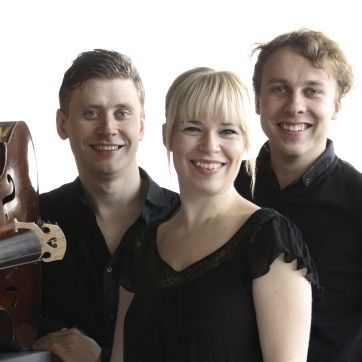Sibelius 1865 – 2015: Sibelius 150 Trio: viool – cello – piano
22 november 2015 | 16.45 uur
| Museum Geelvinck Hinlopen Huis,

The ‘Sibelius 150 Trio’, comprises Tuomas Lehto, cello – Siljamari Heikinheimo, violin – Roope Grondahl, piano – and has been formed to celebrate the musical legacy Finland’s national composer Jean Sibelius.
Programma:
Jean Sibelius (1865-1957): ‘Sibelius 150 Trio’
– Four Lyric Pieces Opus 74 for piano (1914)
– Theme and Variations for solo cello (1887)
– Danses Champetres for violin and piano op. 106 (1924)
——————— pauze —————–
– Malinconia for cello and piano op. 20 (1900)
– Piano trio C Major “Loviisa” (1888)
Recencie:
It’s the 150th anniversary of the birth of Sibelius and we heard a fabulous program of Sibelius music from the Sibelius 150 Trio. This may not be their permanent name, but they are touring as that and playing exclusively (at least for this concert) the music of Sibelius and they were wonderful. Great music, wonderfully performed, nicely varied. S150 are a trio of piano, violin and cello, but this was not just a program of trio numbers. This was varied: solos from piano and cello, duos from piano with violin and another with cello and a full trio. Do I have a favourite instrument of these? Perhaps the cello, played so generously with luscious vibrato and that rich deeper tone. But then the violin was fabulous, all busy and lively as they are written to be, earthy with some rabid pizzicato, high and flying. And the piano, full ranged and full bodied and harmonically colourful. I think of Sibelius as the Finnish national composer, like Verdi (strangely, it’s his name but also the acronym of the king’s name, Vittorio Emanuelle Re d’Italia, at the time of Garibaldi and Italian nationalism) is for the more flamboyant Italians. I expect folk themes but Sibelius ranges over classical and romantic and this was evident.
The program mentions classical antiquity and Debussy and Ravel and dances for the piano pieces (Four Lyric Pieces for piano op. 74, 1914). The solo cello was themes and variations with likenesses to Bach and Paganini (Theme and Variations in D minor for solo cello, 1887). Then some folkish dances played in violin-piano duo (Danses Champêtres for violin and piano Op.106, 1924) and a moody cello-piano duo written in defiant sorrow after the death of his daughter (Malinconia for cello and piano Op.20, 1900). Finally, a piano trio that “shows Sibelius moving from classical paragons to a more romantic expression”* (Piano trio C Major “Loviisa”, 1888). They encored with a shorter Romance in F major, leaving to great applause and a very satisfied audience. Tuomas, Siljamari and Roope all studied at the Sibelius Academy in Finland and elsewhere. They have senior roles in Finnish orchestras and considerable experience between them. It shows. Very much enjoyed.
Canberra Jazz blog, 17 march 2015

